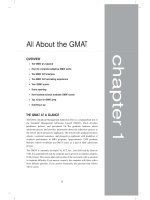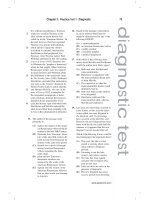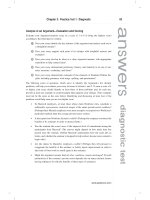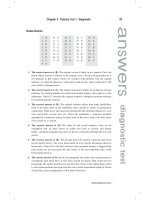Master gmat 2010 part 2 ppt
Bạn đang xem bản rút gọn của tài liệu. Xem và tải ngay bản đầy đủ của tài liệu tại đây (49.68 KB, 10 trang )
Top 10 Wrong-Answer Ploys 410
Keys to Successful GMAT Reading Comprehension: The Basics 410
Keys to Successful GMAT Reading Comprehension:
Advanced Techniques 412
Summing It Up 414
PART VI: FIVE PRACTICE TESTS
Practice Test 2 423
Analytical Writing Assessment 423
Quantitative Section 425
VerbalSection 432
Answer Keys and Explanations 446
Practice Test 3 471
Analytical Writing Assessment 471
Quantitative Section 473
VerbalSection 480
Answer Keys and Explanations 494
Practice Test 4 517
Analytical Writing Assessment 517
Quantitative Section 519
VerbalSection 525
Answer Keys and Explanations 539
Practice Test 5 561
Analytical Writing Assessment 561
Quantitative Section 563
VerbalSection 570
Answer Keys and Explanations 585
Practice Test 6 607
Analytical Writing Assessment 607
Quantitative Section 609
VerbalSection 616
Answer Keys and Explanations 631
APPENDIXES
Appendix A: Resources for GMAT Preparation 651
Appendix B: Determining Your Score 657
Appendix C: Word List 659
Contents xi
www.petersons.com
Before You Begin
HOW THIS BOOK IS ORGANIZED
Taking the GMAT is a skill. It shares some aspects with other endeavors, such
as competing in athletics. It requires discipline and practice to succeed.
These are skills that can be improved through coaching, but ultimately,
improvement also requires practice. This book gives you both.
• Top 10 Strategies to Raise Your Score lists the ten most
important test-taking tips to help you score high on the GMAT.
• Part I provides essential information on the GMAT, including where
to take it and how it’s scored. You’ll also learn what subjects are
covered and what traps to watch out for. This part of the book also
shows you each test section and each basic type of question up close;
we’ve provided examples of each type of question (along with
explanations), so you can get a good initial feel for the overall test.
• Part II is a diagnostic test of the GMAT’s Quantitative and Verbal
Sections. This will give you your first chance to work with samples of
GMAT question types. Use the results of this test to determine
where you need to focus your GMAT preparation.
• Parts III through V make up the coaching program. This part of
the book analyzes each section of the GMAT exam—Analytical
Writing, Quantitative Questions, and Verbal Questions—and pro-
vides powerful test-taking strategies, both basic and advanced, for
successfully attacking every question type you’ll encounter in the
actual exam.
• Part VI consists of five full-length practice tests with detailed
answer explanations for each question. Each test contains the same
number and mix of question types you will encounter on the actual
GMAT. The answer explanations are invaluable for helping you
learn from your mistakes. To accurately measure your performance,
be sure to adhere strictly to the stated time limits for each section.
• The Appendixes provide resources for GMAT preparation, help you
calculate your GMAT score, and provide a handy vocabulary list to
help you prepare for the Verbal Section of the GMAT.
xiii
Because the actual GMAT is computerized, you’ll be entering answers on the actual exam by
typing on a keyboard or using a mouse. Some parts of the exam, such as the Analytical
Writing section, require you to type sentences and paragraphs. The other two sections require
that you fill in the answer by typing a whole number in a box, checking off boxes in a grid
using the computer mouse, or filling in blanks in a sentence with your mouse by “dragging
and dropping” your chosen answer choices to the blanks. Obviously, answering in this fashion
isn’t possible in a printed book—you’ll have to fill in your answers by hand when taking the
diagnostic and practice tests we’ve provided. To remain consistent with the actual
exam, however, we’ve retained references to “clicking,” “typing,” or “dragging and dropping”
the answers.
SPECIAL STUDY FEATURES
Peterson’s Master the GMAT 2010 is designed to be as user-friendly as it is complete. To this
end, it includes several features to make your preparation more efficient.
Overview
Each chapter begins with a bulleted overview listing the topics covered in the chapter. This
will allow you to quickly target the areas in which you are most interested.
Summing It Up
Each chapter ends with a point-by-point summary that reviews the most important items in
the chapter. The summaries offer a convenient way to review key points.
Bonus Information
As you work your way through the book, look for bonus information and advice in the margins
of the pages. Information is in the following forms:
NOTE
Notes highlight need-to-know information about the GMAT, whether it’s details about
registration and scoring or the structure of a question type.
TIP
Tips provide valuable strategies and insider information to help you score your best on
the GMAT.
ALERT!
Alerts do just what they say—alert you to common pitfalls and misconceptions you might face
or hear regarding the GMAT.
xiv Before You Begin
www.petersons.com
ABOUT THE CD
The CD accompanying this book provides the latest computerized testing software, which
closely replicates the testing experience of the actual test. The software was developed by
Peterson’s and the practice test content was created by the test prep experts at Peterson’s.
YOU’RE WELL ON YOUR WAY TO SUCCESS
You’ve made the decision to apply to graduate school. Peterson’s Master the GMAT will help
prepare you for the steps you’ll need to take to achieve your goal—from scoring high on the
exam to being admitted to the graduate program of your choice. Good luck!
GIVE US YOUR FEEDBACK
Peterson’s publishes a full line of resources to help guide you through the graduate school
admission process. Peterson’s publications can be found at your local bookstore or library, and
you can access us online at www. petersons.com.
We welcome any comments or suggestions you may have about this publication and invite you
to complete our online survey at www.petersons.com/booksurvey. Or you can fill out the
survey at the back of this book, tear it out, and mail it to us at:
Publishing Department
Peterson’s, a Nelnet company
2000 Lenox Drive
Lawrenceville, NJ 08648
Your feedback will help us make your education dreams come true.
Before You Begin xv
www.petersons.com
TOP 10 STRATEGIES TO RAISE YOUR SCORE
Later in the book we’ll review strategies and tips for specific test sections and
question types. Right now, however, here’s a list of general strategies for the GMAT.
Even if you’ve read about these strategies elsewhere, or if they seem like common
sense to you, it’s a good idea to reinforce them in your mind.
1. Know your optimal pace and stay on it. Time is definitely a factor on every
section of the GMAT. On the multiple-choice sections, expect to work at a
quicker pace than is comfortable for you. Similarly, the 30-minute time limit for
each Analytical Writing Assessment (AWA) response requires a lively writing
pace, allowing little time for editing, revising, and fine-tuning.
During the multiple-choice sections, check your pace after every 10 questions or
so (three times during a section) and adjust it accordingly so that you have time
to at least consider every question in the section. During each essay section, be
sure to leave yourself enough time to cover all your main points and to wrap up
your essay with a brief concluding paragraph. The best way to avoid the time
squeeze is to practice under timed conditions so that you get a sense of your
optimal pace.
2. If you’re not sure what the correct answer is, don’t dwell on it—move
on. This tip is closely related to the previous one. You might find yourself
reluctant to leave a question until you’re sure your answer is correct. The design
of the computer-adaptive test (CAT) contributes to this mindset, because your
reward for correct responses to difficult questions is greater than your reward
for easier questions. But a stubborn attitude will only defeat you, because it
reduces the number of questions you may attempt, which in turn can lower your
score. Remember: You can miss quite a few questions and still score high. De-
velop a sense of your optimal pace—one that results in the greatest number of
correct responses.
3. Take your time with the first few quantitative and verbal questions.
The CAT uses your responses to the first few questions to move you either up or
down the ladder of difficulty. Of course, you want to move up the ladder. So take
great care with the initial questions—perhaps move at a somewhat slower
pace. Otherwise, you’ll have to answer several questions just to reverse the
trend by proving to the CAT that you’re smarter than it thinks you are.
4. Avoid random guessing. If you must guess, always try to eliminate obvious
wrong-answer choices first, then go with your hunch. Eliminating even one
choice improves your odds. If you’re out of time on a section, there’s no
advantage to guessing randomly on the remaining questions. Why? You might
luck out and guess correctly, but if you don’t, incorrect responses move you
down the ladder of difficulty, and correct responses to easier questions aren’t
worth as much as correct responses to more difficult questions. So on balance,
there’s no net advantage to guessing randomly.
xvi Before You Begin
www.petersons.com
5. Read each question in its entirety, and read every answer choice. You’ll
discover GMAT test designers sometimes “bait” test-takers with tempting
wrong-answer choices. This applies to every type of multiple-choice question on
the exam. So unless you’re quickly running out of time, never confirm an
answer until you’ve read all the choices. This mistake is among the leading
causes of incorrect responses on the GMAT.
6. Maintain an active mind set. During the GMAT, it’s remarkably easy to fall
into a passive mode in which you let your eyes simply pass over the words while
you hope that the correct response jumps out at you as you scan the answer
choices. Fight this tendency. Try “interacting” with the test as you read it. Keep
in mind that each question on the GMAT is designed to measure a specific
ability or skill. Adopting an active, investigative approach to each question will
help. Ask yourself:
• What skill is the question measuring?
• What is the most direct thought process to determine the correct
response?
• How might a careless test-taker be tripped up on this type of question?
Answering these three questions is, in large part, what the rest of this book is
all about.
7. Use your pencil and scratch paper. Using pencil and paper helps keep your
mind in an active mode. Making brief notes and drawing diagrams and flow
charts will help keep your thought process clear.
8. Move the keyboard aside for the multiple-choice sections. You won’t use
the keyboard at all for these sections, so put your scratch paper right in front of
you and get the keyboard out of the way.
9. Know the test directions inside and out—before you take the test. Just
before the first question of each type (e.g., Data Sufficiency or Reading
Comprehension), the CAT will display the directions for that question type. The
clock will be running while you’re reading these directions. You can save
valuable time by dismissing the directions as quickly as possible (by clicking on
the DISMISS DIRECTIONS button)—presuming you’ve already made yourself
familiar with the directions before exam time.
10. Use the 10-minute breaks, but keep an eye on the time. Remember: The
GMAT CAT clock is always running, even during the two scheduled 10-minute
breaks. By all means, take advantage of these breaks to leave the room,
perhaps grab a quick snack from your locker, and do some stretching or
relaxing. But don’t get too relaxed: Ten minutes goes by very quickly and the
test will begin after that time has elapsed—with or without you.
Before You Begin xvii
www.petersons.com
P
ART I
GMAT BASICS
CHAPTER 1 All About the GMAT
CHAPTER 2 GMAT Questions: A First Look









